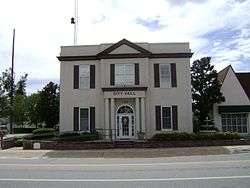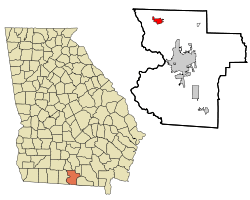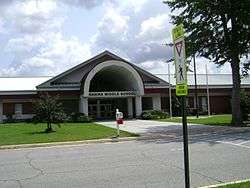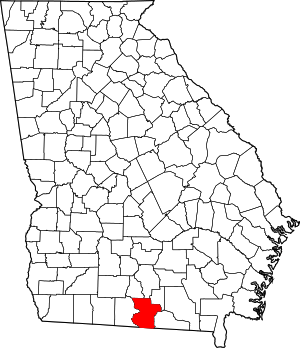Hahira, Georgia
Hahira is a city in northwest Lowndes County, Georgia, United States. The population was 2,737 at the 2010 census,[2] up from 1,626 at the 2000 census.
Hahira, Georgia | |
|---|---|
 Hahira City Hall | |
 Location in Lowndes County and the state of Georgia | |
| Coordinates: 30°59′26″N 83°22′17″W | |
| Country | United States |
| State | Georgia |
| County | Lowndes |
| Area | |
| • Total | 2.80 sq mi (7.26 km2) |
| • Land | 2.69 sq mi (6.97 km2) |
| • Water | 0.11 sq mi (0.29 km2) |
| Elevation | 225 ft (69 m) |
| Population | |
| • Total | 2,737 |
| • Estimate (2019)[3] | 3,029 |
| • Density | 1,125.60/sq mi (434.55/km2) |
| Time zone | UTC-5 (Eastern (EST)) |
| • Summer (DST) | UTC-4 (EDT) |
| ZIP code | 31632 |
| Area code(s) | 229 |
| FIPS code | 13-36052[4] |
| GNIS feature ID | 0315009[5] |
| Website | www |
Hahira has a mayor-council form of elected government. It is led by Mayor Bruce Cain and the four members of the City Council, elected from single-member districts.[6] The city is mentioned in several songs by comedian/songwriter Ray Stevens, most notably the song "Shriner's Convention."[7]
History
According to legend, the town of Hahira was named after a local cotton plantation. The planter was said to have named his estate after a West African village, Hairaairee, which was described to him by an English traveler.[8][9] According to another version, the name may be derived from Hahiroth, a place mentioned in the Hebrew Bible.[10]
The Georgia General Assembly incorporated Hahira in 1891.[11]
Geography
Hahira is located at 30°59′26″N 83°22′17″W (30.990537, -83.371433).[12] U.S. Route 41 passes through the center of town as Church Street, leading north 4 miles (6 km) to Cecil and south 14 miles (23 km) to Valdosta, the county seat. Interstate 75 passes through the west side of Hahira, with access from Exit 29 (Georgia State Route 122). I-75 leads north 33 miles (53 km) to Tifton and south past Valdosta 74 miles (119 km) to Lake City, Florida. State Route 122 is Hahira's Main Street and leads east 18 miles (29 km) to Lakeland and west 22 miles (35 km) to Pavo.
According to the United States Census Bureau, Hahira has a total area of 2.80 square miles (7.26 km2), of which 2.69 square miles (6.97 km2) are land and 0.11 square miles (0.29 km2), or 4.00%, are water.[13] Franks Creek runs through the westernmost part of the city and is part of the Little River–Withlachoochee River–Suwannee River watershed, flowing to the Gulf of Mexico.
Demographics
| Historical population | |||
|---|---|---|---|
| Census | Pop. | %± | |
| 1900 | 365 | — | |
| 1910 | 346 | −5.2% | |
| 1920 | 401 | 15.9% | |
| 1930 | 420 | 4.7% | |
| 1940 | 537 | 27.9% | |
| 1950 | 1,010 | 88.1% | |
| 1960 | 1,297 | 28.4% | |
| 1970 | 1,363 | 5.1% | |
| 1980 | 1,534 | 12.5% | |
| 1990 | 1,353 | −11.8% | |
| 2000 | 1,626 | 20.2% | |
| 2010 | 2,737 | 68.3% | |
| Est. 2019 | 3,029 | [3] | 10.7% |
| U.S. Decennial Census[14] | |||
As of the census[4] of 2000, there were 1,626 people, 643 households, and 448 families residing in the city. The population density was 739.4 people per square mile (285.4/km2). There were 715 housing units at an average density of 325.1 per square mile (125.5/km2). The racial makeup of the city was 73.49% White, 22.32% African American, 0.92% Native American, 0.31% Asian, 1.97% from other races, and 0.98% from two or more races. Hispanic or Latino of any race were 4.43% of the population.
There were 643 households, out of which 37.9% had children under the age of 18 living with them, 46.5% were married couples living together, 18.7% had a female householder with no husband present, and 30.3% were non-families. 27.7% of all households were made up of individuals, and 15.1% had someone living alone who was 65 years of age or older. The average household size was 2.50 and the average family size was 3.08.
In the city, the population was spread out, with 29.4% under the age of 18, 8.1% from 18 to 24, 30.4% from 25 to 44, 18.4% from 45 to 64, and 13.8% who were 65 years of age or older. The median age was 32 years. For every 100 females, there were 83.5 males. For every 100 females age 18 and over, there were 80.8 males.
The median income for a household in the city was $27,946, and the median income for a family was $37,188. Males had a median income of $27,121 versus $18,981 for females. The per capita income for the city was $12,899. About 13.9% of families and 17.6% of the population were below the poverty line, including 23.1% of those under age 18 and 19.6% of those age 65 or over.
Education
Students in Hahira are part of the Lowndes County School District. The following schools are in Hahira:
- Hahira Elementary School
- Hahira Middle School
The South Georgia Regional Library operates the Walter R. & Dorothy Salter Hahira Library. Prior to the March 12, 1989 opening of the current library, the city hall housed a library open once per week. After the state government offered a grant for building libraries, the citizens of Hahira were divided between those who wanted a library and those who wanted water infrastructure upgrades. Mayor Walter R. Salter advocated for the construction of a library, and his wife Dorothy donated $30,000 towards the said construction when Salter died in 1984. In 2010 the library received a renovation. done by Cauthan Construction Company, of the outside and inside worth $80,000.[15]
 Hahira Elementary School
Hahira Elementary School Hahira Middle School
Hahira Middle School Walter R. & Dorothy Salter Hahira Library
Walter R. & Dorothy Salter Hahira Library
Clothing ordinance
Citing public safety concerns, in March 2008, the Hahira City Council, with a vote by the mayor, passed a clothing ordinance that bans residents from wearing pants that have a top falling below the waist in fit and reveal skin or undergarments (see sagging). The council was split 2–2, and their tie was broken by the mayor in favor of the ordinance.[16]
Notable people
- Stephen Drew and J. D. Drew, brothers and Major League Baseball players
- Althea Garrison, city councilor, Boston, Massachusetts
- Jerry Manuel, Major League Baseball manager
- Mark and Dean Mathis, singers of the song "Bread and Butter"
- Lizz Wright, jazz singer and composer
Hahira Honey Bee Festival
Begun in 1981, the Honey Bee Festival is an annual event held during the first week of October. It has become one of the largest festivals in south Georgia, attracting thousands each year, and featuring arts, crafts, a beauty pageant and a parade. It is said that the Honey Bee Festival attracts close to 15,000 visitors.[17]
Great Hahira Pick-In
From the early 1980s to the mid-1990s, Wilby and Gloria Coleman of Valdosta, together with family and friends, sponsored an annual bluegrass festival in Hahira. The Pick-In featured a weekend of bluegrass bands on the mountain stage as well as pickers and grinners in camp sites throughout the city. Citing falling revenues, organizers ended the Pick-Ins in the mid-1990s. In the Fall of 2009, Harvey's Supermarket sponsored a "Great Hahira Pick-In," before building a store on the traditional site of the festival.[18]
References
- "2019 U.S. Gazetteer Files". United States Census Bureau. Retrieved July 9, 2020.
- "Profile of General Population and Housing Characteristics: 2010 Census Summary File 1 (DP-1), Hahira city, Georgia". American FactFinder. U.S. Census Bureau. Archived from the original on February 13, 2020. Retrieved December 16, 2019.
- "Population and Housing Unit Estimates". United States Census Bureau. May 24, 2020. Retrieved May 27, 2020.
- "U.S. Census website". United States Census Bureau. Retrieved 2008-01-31.
- "US Board on Geographic Names". United States Geological Survey. 2007-10-25. Retrieved 2008-01-31.
- "Archived copy". Archived from the original on 2010-12-14. Retrieved 2010-08-20.CS1 maint: archived copy as title (link)
- McKeown, Trevor W. "Ray Stevens' Shriner's Convention". freemasonry.bcy.ca. Retrieved 30 March 2018.
- - Hahira, official municipal website
- University of Georgia Press (1996). The New Georgia Guide. University of Georgia Press. p. 557. Retrieved 3 December 2013.
- Krakow, Kenneth K. (1975). Georgia Place-Names: Their History and Origins (PDF). Macon, GA: Winship Press. p. 101. ISBN 0-915430-00-2.
- Acts and Resolutions of the General Assembly of the State of Georgia. Clark & Hines, State Printers. 1892. p. 819.
- "US Gazetteer files: 2010, 2000, and 1990". United States Census Bureau. 2011-02-12. Retrieved 2011-04-23.
- "U.S. Gazetteer Files: 2019: Places: Georgia". U.S. Census Bureau Geography Division. Retrieved December 16, 2019.
- "Census of Population and Housing". Census.gov. Retrieved June 4, 2015.
- "Salter Hahira Library." South Georgia Regional Library. Retrieved on May 10, 2017.
- "Hahira passes clothing ordinance" Archived 2013-02-05 at Archive.today, Valdosta Daily Times ]
- "This website is currently unavailable". www.hahirahoneybeefestivalinc.com. Retrieved 30 March 2018.
- Fulton, Malynda. "The Great Hahira Pick-In". Retrieved 30 March 2018.
External links
| Wikimedia Commons has media related to Hahira, Georgia. |
